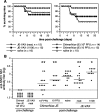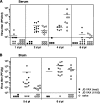Live chimeric and inactivated Japanese encephalitis virus vaccines differ in their cross-protective values against Murray Valley encephalitis virus
- PMID: 19109382
- PMCID: PMC2648276
- DOI: 10.1128/JVI.02273-08
Live chimeric and inactivated Japanese encephalitis virus vaccines differ in their cross-protective values against Murray Valley encephalitis virus
Abstract
The Japanese encephalitis virus (JEV) serocomplex, which also includes Murray Valley encephalitis virus (MVEV), is a group of antigenically closely related, mosquito-borne flaviviruses that are responsible for severe encephalitic disease in humans. While vaccines against the prominent members of this serocomplex are available or under development, it is unlikely that they will be produced specifically against those viruses which cause less-frequent disease, such as MVEV. Here we have evaluated the cross-protective values of an inactivated JEV vaccine (JE-VAX) and a live chimeric JEV vaccine (ChimeriVax-JE) against MVEV in two mouse models of flaviviral encephalitis. We show that (i) a three-dose vaccination schedule with JE-VAX provides cross-protective immunity, albeit only partial in the more severe challenge model; (ii) a single dose of ChimeriVax-JE gives complete protection in both challenge models; (iii) the cross-protective immunity elicited with ChimeriVax-JE is durable (>or=5 months) and broad (also giving protection against West Nile virus); (iv) humoral and cellular immunities elicited with ChimeriVax-JE contribute to protection against lethal challenge with MVEV; (v) ChimeriVax-JE remains fully attenuated in immunodeficient mice lacking type I and type II interferon responses; and (vi) immunization with JE-VAX, but not ChimeriVax-JE, can prime heterologous infection enhancement in recipients of vaccination on a low-dose schedule, designed to mimic vaccine failure or waning of vaccine-induced immunity. Our results suggest that the live chimeric JEV vaccine will protect against other viruses belonging to the JEV serocomplex, consistent with the observation of cross-protection following live virus infections.
Figures




Similar articles
-
An inactivated Vero cell-grown Japanese encephalitis vaccine formulated with Advax, a novel inulin-based adjuvant, induces protective neutralizing antibody against homologous and heterologous flaviviruses.J Gen Virol. 2010 Jun;91(Pt 6):1407-17. doi: 10.1099/vir.0.019190-0. Epub 2010 Feb 3. J Gen Virol. 2010. PMID: 20130134 Free PMC article.
-
Chimeric live, attenuated vaccine against Japanese encephalitis (ChimeriVax-JE): phase 2 clinical trials for safety and immunogenicity, effect of vaccine dose and schedule, and memory response to challenge with inactivated Japanese encephalitis antigen.J Infect Dis. 2003 Oct 15;188(8):1213-30. doi: 10.1086/378356. Epub 2003 Oct 3. J Infect Dis. 2003. PMID: 14551893 Clinical Trial.
-
Recombinant, chimaeric live, attenuated vaccine (ChimeriVax) incorporating the envelope genes of Japanese encephalitis (SA14-14-2) virus and the capsid and nonstructural genes of yellow fever (17D) virus is safe, immunogenic and protective in non-human primates.Vaccine. 1999 Apr 9;17(15-16):1869-82. doi: 10.1016/s0264-410x(98)00487-3. Vaccine. 1999. PMID: 10217584
-
Japanese encephalitis vaccines: Immunogenicity, protective efficacy, effectiveness, and impact on the burden of disease.Hum Vaccin Immunother. 2017 Jun 3;13(6):1-18. doi: 10.1080/21645515.2017.1285472. Epub 2017 Feb 22. Hum Vaccin Immunother. 2017. PMID: 28301270 Free PMC article. Review.
-
IMOJEV(®): a Yellow fever virus-based novel Japanese encephalitis vaccine.Expert Rev Vaccines. 2010 Dec;9(12):1371-84. doi: 10.1586/erv.10.139. Expert Rev Vaccines. 2010. PMID: 21105774 Review.
Cited by
-
Flavivirus serocomplex cross-reactive immunity is protective by activating heterologous memory CD4 T cells.Sci Adv. 2018 Jul 4;4(7):eaar4297. doi: 10.1126/sciadv.aar4297. eCollection 2018 Jul. Sci Adv. 2018. PMID: 29978039 Free PMC article.
-
An inactivated Vero cell-grown Japanese encephalitis vaccine formulated with Advax, a novel inulin-based adjuvant, induces protective neutralizing antibody against homologous and heterologous flaviviruses.J Gen Virol. 2010 Jun;91(Pt 6):1407-17. doi: 10.1099/vir.0.019190-0. Epub 2010 Feb 3. J Gen Virol. 2010. PMID: 20130134 Free PMC article.
-
Feasibility of cross-protective vaccination against flaviviruses of the Japanese encephalitis serocomplex.Expert Rev Vaccines. 2012 Feb;11(2):177-87. doi: 10.1586/erv.11.180. Expert Rev Vaccines. 2012. PMID: 22309667 Free PMC article. Review.
-
Japanese Encephalitis Virus: The Emergence of Genotype IV in Australia and Its Potential Endemicity.Viruses. 2022 Nov 9;14(11):2480. doi: 10.3390/v14112480. Viruses. 2022. PMID: 36366578 Free PMC article. Review.
-
A replication-defective Japanese encephalitis virus (JEV) vaccine candidate with NS1 deletion confers dual protection against JEV and West Nile virus in mice.NPJ Vaccines. 2020 Aug 5;5(1):73. doi: 10.1038/s41541-020-00220-4. eCollection 2020. NPJ Vaccines. 2020. PMID: 32802412 Free PMC article.
References
-
- Barrett, A. T., and E. A. Gould. 1986. Antibody-mediated early death in vivo after infection with yellow fever virus. J. Gen. Virol. 672539-2542. - PubMed
-
- Beasley, D. W., P. Lewthwaite, and T. Solomon. 2008. Current use and development of vaccines for Japanese encephalitis. Expert Opin. Biol. Ther. 895-106. - PubMed
-
- Broom, A. K., M. J. Wallace, J. S. Mackenzie, D. W. Smith, and R. A. Hall. 2000. Immunization with gamma globulin of Murray Valley encephalitis virus and with an inactivated Japanese encephalitis virus vaccine as prophylaxis against Australian encephalitis: evaluation in a mouse model. J. Med. Virol. 61259-265. - PubMed
-
- Burke, D. S., and T. P. Monath. 2001. Flaviviruses, p. 1043-1126. In D. M. Knipe and P. M. Howley (ed.), Fields virology, 4th ed. Lippincott Williams & Wilkins, Philadelphia, PA.
-
- Clark, D. C., M. Lobigs, E. Lee, M. J. Howard, K. Clark, B. J. Blitvich, and R. A. Hall. 2007. In situ reactions of monoclonal antibodies with a viable mutant of Murray Valley encephalitis virus reveal an absence of dimeric NS1 protein. J. Gen. Virol. 881175-1183. - PubMed
MeSH terms
Substances
LinkOut - more resources
Full Text Sources

